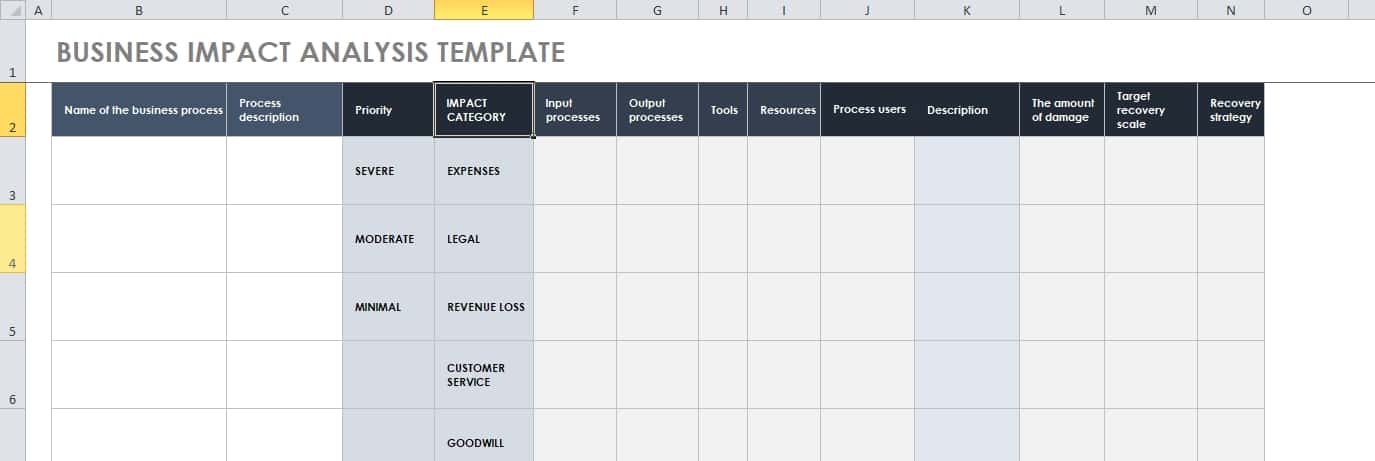Business impact analysis or BIA is an activity to assess unpredictable risks from the external environment (natural disasters, unnatural disasters, emergencies, etc.). The basis for business impact analysis is the thesis: all organization components create a system, but some are so important that operations will cease without them. These components can be determined using impact analysis.
A comprehensive analysis of the impact on business is aimed at those industries whose work needs to be adjusted no later than a day after force majeure. The direction can be restored later with a basic analysis because its damage does not threaten the business.
It is necessary to conduct a business impact analysis to:
- Reduce potential damage from unforeseen factors and develop a plan to protect assets and data.
- Determine if there is synergy among the company’s departments and how strong it is.
- Find out what the company needs to work with the least productivity.
- Be ready for constant changes in the external environment and maintain a competitive advantage.
Business impact analysis helps avoid reduced profits, equipment breakdowns, additional payroll costs, fines, etc.
6 Business Impact Analysis Steps
This article will take a closer look at the six steps of business impact analysis.
Identify Resources to Use for BIA template & Analysis

To begin with, it is necessary to consider all the resources of the enterprise (work team, finance, tangible assets, information). This analysis in the company should be carried out by a separate department (manager responsible for continuity planning, business analyst, IT specialist). To obtain information that the company can effectively apply, it is necessary to identify key individuals.
Conduct Information Gathering for Business Impact Analysis
Next, a questionnaire is created to survey previously selected people. The purpose of this stage is to group all the necessary information about the potential impact of risk factors and unplanned incidents on the business. The company must be prepared for every unpredictable impact of the surrounding reality. The survey should contain questions concerning the smallest details. All items should contain only the relevant information to the specific business impact analysis. Here is a practical example of a questionnaire:
- Department – you can start by collecting information about the department/region, creating a list of contacts.
- Processes – what kind of work is carried out by this department?
- Correlation – what is the relationship between process and department?
- Prioritization – Rank the processes from most important to least important.
- Alternative – is there a replacement for the process?
- Threat – how will the company suffer during a possible kurtosis?
- Permissible disruption time – for what maximum period can the department’s work be stopped without loss?
- Recovery – how long does it take for the department to resume operations?
- Losses – what will be the monetary impact?
Respondents should also be asked to provide their comments. Employees can point out details that were not noticed.
Document Findings of Business Impact Assessment

The next step is to generate a business impact analysis template. If there are 1-2 respondents, and all data were entered into an Excel spreadsheet or Google Spreadsheet, the template will be ready for analysis at the end of the survey. If there are many more interviewees, it is recommended to use specially designed cloud templates.
Validate Findings with BIA Business Resources
Before submitting the report to the persons responsible for making the different decisions, we recommend reviewing the data again. Evaluate how objectively and truthfully the information is reflected. This step can identify potential data that will complement the report.
Chart Impact on Business in a Business Impact Analysis Tool
Visualize information through lists, charts, and pictures. The test report should include a large amount of analytical information to help business managers to take the most effective actions.
Present BIA Analysis Findings & Recommendations

The final stage of the business impact analysis is creating and presenting the final report, which will present the results of the study and recommendations. What can they be?
- Decrease/increase project implementation time.
- Start cooperation with certain companies.
- Reorganize departments, etc.
The main elements of the report:
- Summary (summary of the situation).
- Information about the methodology.
- Details of the present and future state of the process.
- Analysis and its visualization.
- Prioritization of impacts.
- Financial information related to losses and risks.
- Consultant recommendations.
By paying due attention to all of the points, you will make an adequate report on the impact on the business of possible hazards.
Business Impact Analysis vs. Risk Assessment
BIA and risk assessment form the emergency upgrade strategy. Often these concepts are confused, but their elements are not interchangeable.
What is the difference? The company determines the likelihood of an exceptional situation through risk assessment, while the external impact analysis describes the negative consequences.
Typically, the risks are associated with the loss of customers, an increase in the price of raw materials, or technical failures in computer systems. In addition, they separately examine risks that are not directly related to the company’s activities: weather disasters, terrorist attacks, inflation, political crises, wars, etc. They also highlight risks associated with the human factor:
- A colleague accidentally or deliberately deleted a file on an office PC.
- The necessary documents were thoughtlessly thrown away or lost in the accounting department.
- Through a team member’s fault or malicious intent, competitors learned inside confidential information.
The main consequences of these problems, reflected in the BIA report, are financial losses: a decrease in the company’s income, increased wages, an urgent purchase of certain tools or programs. In addition, sometimes the situation leads to the loss of consumers or their loyalty, the dismissal of qualified employees, the loss of trust of partners or creditors, etc.
The Business Impact Analysis Report will vary from company to company instead of the Risk Assessment Report, which may contain similar information.
Business Impact Analysis Template
The business impact analysis template will differ depending on the niche of the business or department of the company. But some elements are specific to any template:

- The name of the business process. Example: "replacement of a technological line" or "change of industry positioning."
- Process description. All necessary details of the process and the predicted, planned changes are indicated. Example: "software optimization for skill development."
- Priority. How does the process affect business promotion? How serious will be the consequences of this business process being idle without modernization? Record the score on a scale of "minimum," "moderate," or "severe" impact.
- Impact category. Which area will change due to the impact of this business process (operational activities, regulatory framework, etc.)?
- Input and output processes. Basic operations of the process.
- Tools and resources used in the process. Information, financial – any sources that need to be used to restore the process.
- Process users. All people involved in using the required process (company personnel).
- Description of how the loss happened. A detailed description of the events that led to the loss, for example: "as a result of a server fire, our customers lost access to the site and the necessary digital data located on it."
- The amount of damage. An approximate estimate of the damage resulting from the incident is calculated and indicated.
- Target recovery scale for process normalization. Approximate time it will take for the process to return to its normal state.
- Recovery strategy, basic steps. A detailed plan, defined milestones for the recovery process. As a rule, they are explained in the context of a single strategy.
When filling out the template, be careful – in analyzing the impact on the business, every detail, even the smallest one, plays a role.
As a result
Conduct a business impact analysis annually to detect catastrophic environmental impacts on the company’s operations. It will reduce disruptions in business operations and eliminate financial losses. The analysis is necessary to determine the critical areas that affect the company’s development.
The analysis’s five main stages are aimed at the final result – implementing a plan to improve the work of the affected areas. Keep in mind that business grows and changes, so all recommendations (and influencing factors) need to be regularly reviewed and improved by changes in the external environment.
